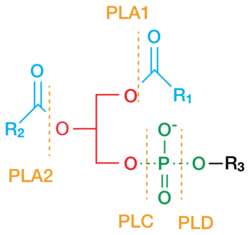Biology:Phospholipase
A phospholipase is an enzyme that hydrolyzes phospholipids[1] into fatty acids and other lipophilic substances. Acids trigger the release of bound calcium from cellular stores and the consequent increase in free cytosolic Ca2+, an essential step in calcium signaling to regulate intracellular processes.[2] There are four major classes, termed A, B, C, and D, which are distinguished by the type of reaction which they catalyze:
- Phospholipase A
- Phospholipase A1 – cleaves the sn-1 acyl chain (where sn refers to stereospecific numbering).
- Phospholipase A2 – cleaves the sn-2 acyl chain, releasing arachidonic acid.
- Phospholipase B – cleaves both sn-1 and sn-2 acyl chains; this enzyme is also known as a lysophospholipase.
- Phospholipase C – cleaves before the phosphate, releasing diacylglycerol and a phosphate-containing head group. PLCs play a central role in signal transduction, releasing the second messenger inositol triphosphate.
- Phospholipase D – cleaves after the phosphate, releasing phosphatidic acid and an alcohol.
Types C and D are considered phosphodiesterases.
Endothelial lipase is primarily a phospholipase.[3]
Phospholipase A2 acts on the intact lecithin molecule and hydrolyzes the fatty acid esterified to the second carbon atom. The resulting products are lysolecithin and a fatty acid. Phospholipase A2 is an enzyme present in the venom of bees, blennies and viper snakes.[4]
See also
References
- ↑ "phospholipase" at Dorland's Medical Dictionary
- ↑ Molinari, Giuliano; Nervo, Elsa (2021-02-26). "Role of protons in calcium signaling". The Biochemical Journal 478 (4): 895–910. doi:10.1042/BCJ20200971. ISSN 1470-8728. PMID 33635336. https://pubmed.ncbi.nlm.nih.gov/33635336/.
- ↑ "The role of endothelial lipase in lipid metabolism, inflammation, and cancer". Histology and Histopathology 33 (1): 1–10. 2018. doi:10.14670/HH-11-905. PMID 28540715.
- ↑ D. M. Vasudevan & S. Sreekumari, Textbook of Biochemistry (5th ed.)
Further reading
- Tappia, Paramjit S. & Dhalla, Naranjan S. (Editors): Phospholipases in Health and Disease. Springer, 2014. ISBN:978-1-4939-0463-1 [Print]; ISBN:978-1-4939-0464-8 [eBook]
External links
- Phospholipases at the US National Library of Medicine Medical Subject Headings (MeSH)
 |


